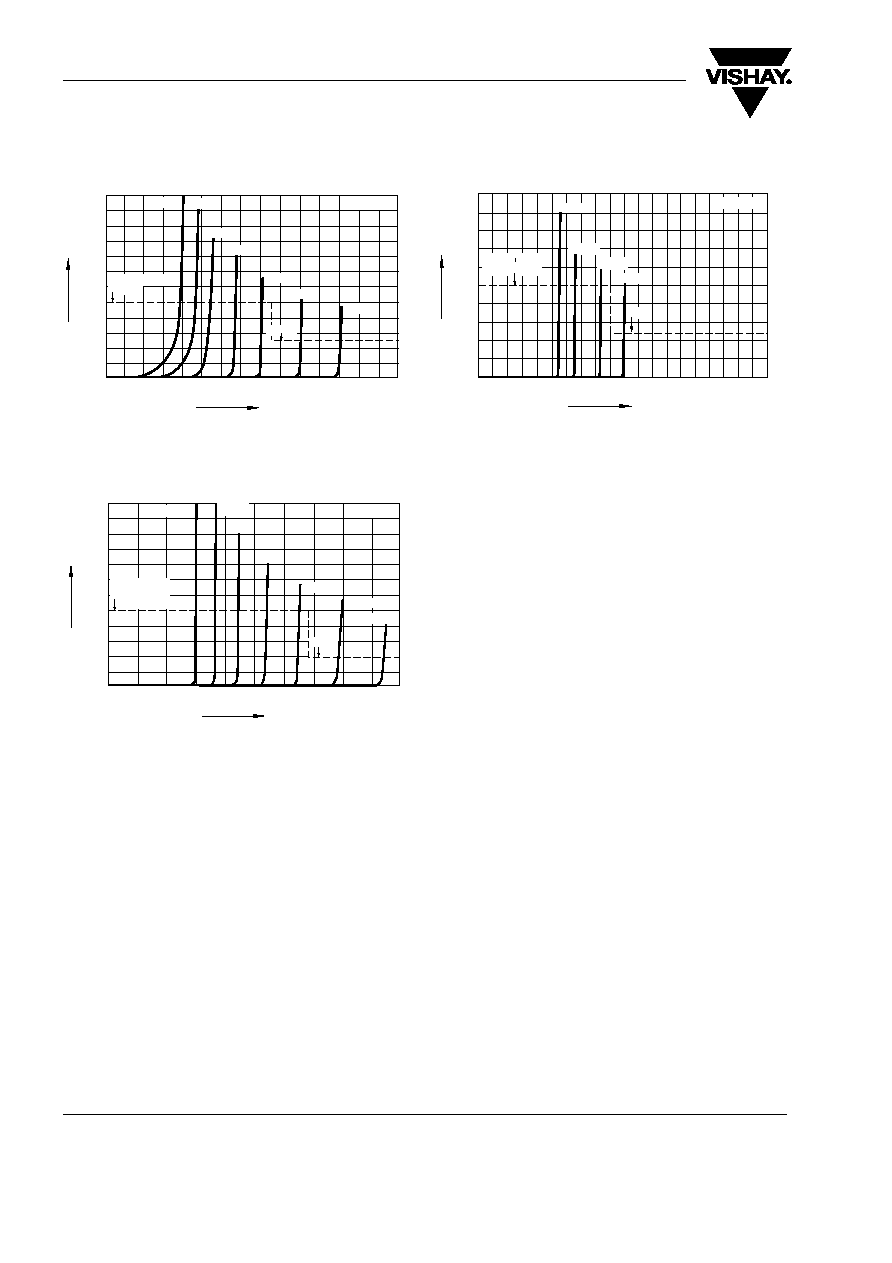
ZMY3V9 to ZMY100
Document Number 85788
Rev. 1.6, 28-Feb-06
Vishay Semiconductors
www.vishay.com
1
18315
Zener Diodes
Features
∑ Silicon Planar Power Zener Diodes
∑ For use in stablilizing and clipping circuits
with high power rating
∑ The Zener voltages are graded according
to the international E 24 standard. Smaller voltage
tolerances are available upon request
∑ These diodes are also available in the DO-41 case
with the type designation ZMY1 ... ZMY100
∑ Lead (Pb)-free component
∑ Component in accordance to RoHS 2002/95/EC
and WEEE 2002/96/EC
Mechanical Data
Case: MELF Glass case
Weight: approx. 135 mg
Packaging Codes/Options:
GS18/ 5 k per 13" reel (12 mm tape), 10 k/box
GS08/ 1.5 k per 7" reel (12 mm tape), 12 k/box
Absolute Maximum Ratings
T
amb
= 25 ∞C, unless otherwise specified
1)
Valid provided that electrodes are kept at ambient temperature.
Thermal Characteristics
T
amb
= 25 ∞C, unless otherwise specified
1)
Valid provided that electrodes are kept at ambient temperature.
Parameter
Test condition
Symbol
Value
Unit
Zener current (see Table "Characteristics")
Power dissipation
P
tot
1.0
1)
W
Parameter
Test condition
Symbol
Value
Unit
Thermal resistance junction to ambient air
R
thJA
170
1)
K/W
Thermal resistance junction to case
R
thJC
60
∞C/W
Junction temperature
T
j
175
∞C
Storage temperature
T
stg
- 55 to + 175
∞C
e2

www.vishay.com
2
Document Number 85788
Rev. 1.6, 28-Feb-06
ZMY3V9 to ZMY100
Vishay Semiconductors
Electrical Characteristics
1)
Valid provided that electrodes are kept at ambient temperature
2)
Tested with pulses t
p
= 5 ms
Partnumber
Zener Voltage (2)
Dynamic Resistance
Temperature
Coefficient of
Zener Voltage
Test
Current
Reverse Voltage
Admissible Zener
Current
1)
V
Z
at I
ZT
r
zj
at I
ZT
, f = 1 kHz
VZ
at I
ZT
I
ZT
V
R
at
I
R
= 0.5 µA
I
Z
at
T
amb
= 25 ∞C
V
10
-4
/∞C
mA
V
mA
min
max
typ
min
max
ZMY3V9
3.7
4.1
7
4
- 7
2
100
-
203
ZMY4V3
4
4.6
7
4
- 7
3
100
-
182
ZMY4V7
4.4
5
7
4
- 7
4
100
-
165
ZMY5V1
4.8
5.4
5
2
- 6
5
100
0.7
150
ZMY5V6
5.2
6
2
1
- 3
5
100
1.5
135
ZMY6V2
5.8
6.6
2
1
- 1
6
100
2
128
ZMY6V8
6.4
7.2
2
1
0
7
100
3
110
ZMY7V5
7
7.9
2
1
0
7
100
5
100
ZMY8V2
7.7
8.7
2
1
3
8
100
6
89
ZMY9V1
8.5
9.6
4
2
3
8
50
7
82
ZMY10
9.4
10.6
4
2
5
9
50
7.5
74
ZMY11
10.4
11.6
7
3
5
10
50
8.5
66
ZMY12
11.4
12.7
7
3
5
10
50
9
60
ZMY13
12.4
14.1
9
4
5
10
50
10
55
ZMY15
13.8
15.8
9
4
5
10
50
11
49
ZMY16
15.3
17.1
10
5
7
11
25
12
44
ZMY18
16.8
19.1
11
5
7
11
25
14
40
ZMY20
18.8
21.2
12
6
7
11
25
15
36
ZMY22
20.8
23.3
13
7
7
11
25
17
34
ZMY24
22.8
25.6
14
8
7
12
25
18
29
ZMY27
25.1
28.9
15
9
7
12
25
20
27
ZMY30
28
32
20
10
7
12
25
22.5
25
ZMY33
31
35
20
11
7
12
25
25
22
ZMY36
34
38
60
25
7
12
10
27
20
ZMY39
37
41
60
30
8
12
10
29
18
ZMY43
40
46
80
35
8
13
10
32
17
ZMY47
44
50
80
40
8
13
10
35
15
ZMY51
48
54
100
45
8
13
10
38
14
ZMY56
52
60
100
50
8
13
10
42
13
ZMY62
58
66
130
60
8
13
10
47
11
ZMY68
64
72
130
65
8
13
10
51
10
ZMY75
70
79
160
70
8
13
10
56
9
ZMY82
77
88
160
80
8
13
10
61
8
ZMY91
85
96
250
120
9
13
5
68
7.5
ZMY100
94
106
250
130
9
13
5
75
7

ZMY3V9 to ZMY100
Document Number 85788
Rev. 1.6, 28-Feb-06
Vishay Semiconductors
www.vishay.com
3
Typical Characteristics
T
amb
= 25 ∞C, unless otherwise specified
Figure 1. Dynamic Resistance vs. Zener Current
Figure 2. Dynamic Resistance vs. Zener Current
Figure 3. Dynamic Resistance vs. Zener Current
1
2
10
100
mA
10
3
10
2
1
r
zj
I
Z
18312
5
4
3
2
5
4
3
2
5
4
3
2
5
4
3
2
5
4
3
10
7
7
ZMY5.1
ZMY4.3
ZMY18
ZMY12
ZMY7.5
ZMY6.2
ZMY10
ZMY...
1
2
10
100
mA
100
10
1
2
5
4
3
r
zj
I
Z
18313
5
4
3
2
5
4
3
7
2
5
4
3
7
ZMY43
ZMY36
ZMY30
ZMY24
ZMY22
ZMY...
ZMY18
ZMY...
0.1
2
1
10
mA
10
3
10
2
10
2
5
4
3
r
zj
I
Z
18314
5
4
3
2
5
4
3
7
2
5
4
3
7
ZMY100
ZMY82
ZMY68
ZMY56
ZMY43
Figure 4. Admissible Power Dissipation vs. Ambient Temperature
Figure 5. Pulse Thermal Resistance vs. Pulse Duration
0
100
200 ∞C
0.8
0.4
0
W
P
tot
T
amb
19969
ZMY...
1.0
0.6
0.2
10
-5
10
-4
10
-3
10
-2
10
-1
1
10
s
10
3
10
2
10
1
∞C/W
2
5
4
3
2
5
4
3
2
5
4
3
r
thA
t
P
18286
t
P
v =
T
P
I
___
T
t
P
0.5
0.2
0.1
0.05
0.02
0.01
ZMY...
V = 0

www.vishay.com
4
Document Number 85788
Rev. 1.6, 28-Feb-06
ZMY3V9 to ZMY100
Vishay Semiconductors
Figure 6. Breakdown Characteristics
Figure 7. Breakdown Characteristics
0
1
2
3
4
5
6
7
8
9
10 11 12 13 14 15 V
0
40
80
120
160
200
240
mA
I
Z
V
Z
18309
ZMY...
T
j
= 25 ∞C
Test Current l
Z
100 mA
50 mA
ZMY4.7
ZMY3.9
ZMY5.6
ZMY6.8
ZMY8.2
ZMY10
ZMY12
0
5
10
15
20
25
30
35
40
45 50 V
10
20
30
40
50
60
mA
I
Z
V
Z
18310
T
j
= 25 ∞C
ZMY...
Test Current l
Z
25 mA
10 mA
ZMY22
ZMY18
ZMY27
ZMY33
ZMY15
ZMY39
ZMY47
0
Figure 8. Breakdown Characteristics
0
100
200 V
0
10
20
mA
I
Z
V
Z
18311
50
150
Test Current l
Z
10 mA
5 mA
Tj = 25 ∞C
ZMY56
ZMY68
ZMY82
ZMY100
ZMY...

ZMY3V9 to ZMY100
Document Number 85788
Rev. 1.6, 28-Feb-06
Vishay Semiconductors
www.vishay.com
5
Package Dimensions of MELF Glass in mm (Inches)
18317

www.vishay.com
6
Document Number 85788
Rev. 1.6, 28-Feb-06
ZMY3V9 to ZMY100
Vishay Semiconductors
Ozone Depleting Substances Policy Statement
It is the policy of Vishay Semiconductor GmbH to
1. Meet all present and future national and international statutory requirements.
2. Regularly and continuously improve the performance of our products, processes, distribution and operating
systems with respect to their impact on the health and safety of our employees and the public, as well as
their impact on the environment.
It is particular concern to control or eliminate releases of those substances into the atmosphere which are
known as ozone depleting substances (ODSs).
The Montreal Protocol (1987) and its London Amendments (1990) intend to severely restrict the use of ODSs
and forbid their use within the next ten years. Various national and international initiatives are pressing for an
earlier ban on these substances.
Vishay Semiconductor GmbH has been able to use its policy of continuous improvements to eliminate the use
of ODSs listed in the following documents.
1. Annex A, B and list of transitional substances of the Montreal Protocol and the London Amendments
respectively
2. Class I and II ozone depleting substances in the Clean Air Act Amendments of 1990 by the Environmental
Protection Agency (EPA) in the USA
3. Council Decision 88/540/EEC and 91/690/EEC Annex A, B and C (transitional substances) respectively.
Vishay Semiconductor GmbH can certify that our semiconductors are not manufactured with ozone depleting
substances and do not contain such substances.
We reserve the right to make changes to improve technical design
and may do so without further notice.
Parameters can vary in different applications. All operating parameters must be validated for each
customer application by the customer. Should the buyer use Vishay Semiconductors products for any
unintended or unauthorized application, the buyer shall indemnify Vishay Semiconductors against all
claims, costs, damages, and expenses, arising out of, directly or indirectly, any claim of personal
damage, injury or death associated with such unintended or unauthorized use.
Vishay Semiconductor GmbH, P.O.B. 3535, D-74025 Heilbronn, Germany

Legal Disclaimer Notice
Vishay
Document Number: 91000
www.vishay.com
Revision: 08-Apr-05
1
Notice
Specifications of the products displayed herein are subject to change without notice. Vishay Intertechnology, Inc.,
or anyone on its behalf, assumes no responsibility or liability for any errors or inaccuracies.
Information contained herein is intended to provide a product description only. No license, express or implied, by
estoppel or otherwise, to any intellectual property rights is granted by this document. Except as provided in Vishay's
terms and conditions of sale for such products, Vishay assumes no liability whatsoever, and disclaims any express
or implied warranty, relating to sale and/or use of Vishay products including liability or warranties relating to fitness
for a particular purpose, merchantability, or infringement of any patent, copyright, or other intellectual property right.
The products shown herein are not designed for use in medical, life-saving, or life-sustaining applications.
Customers using or selling these products for use in such applications do so at their own risk and agree to fully
indemnify Vishay for any damages resulting from such improper use or sale.






